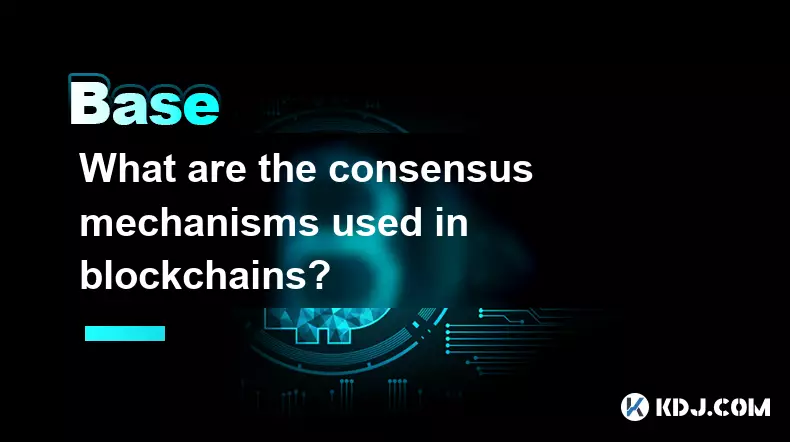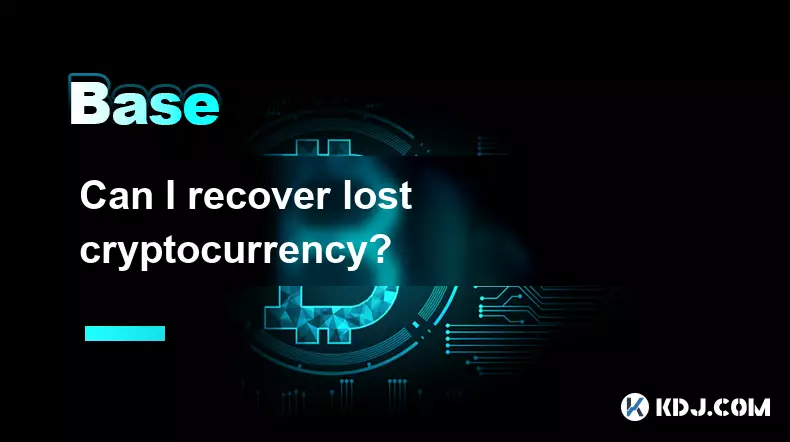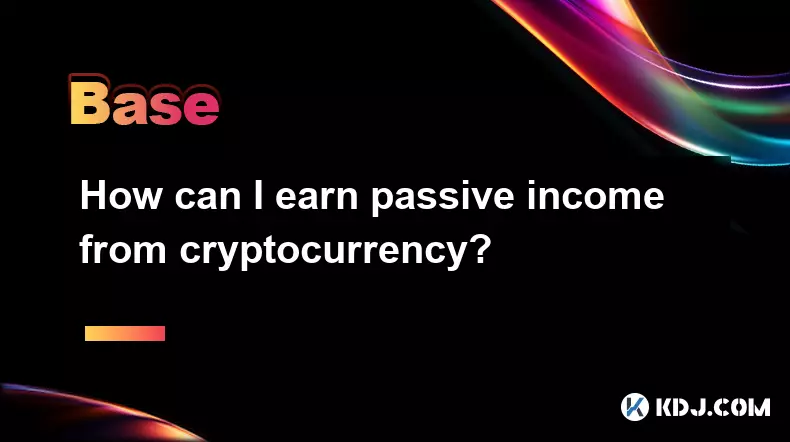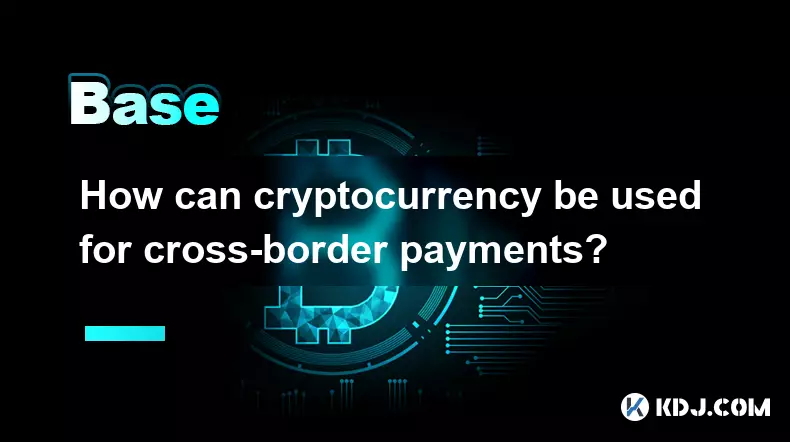-
 bitcoin
bitcoin $112195.049338 USD
2.42% -
 ethereum
ethereum $4124.915858 USD
2.81% -
 tether
tether $1.000570 USD
0.02% -
 xrp
xrp $2.861568 USD
2.25% -
 bnb
bnb $1000.346670 USD
3.04% -
 solana
solana $209.070819 USD
3.38% -
 usd-coin
usd-coin $0.999870 USD
0.02% -
 dogecoin
dogecoin $0.235379 USD
2.65% -
 tron
tron $0.335681 USD
-0.20% -
 cardano
cardano $0.803501 USD
3.38% -
 hyperliquid
hyperliquid $47.120881 USD
3.56% -
 chainlink
chainlink $21.501300 USD
3.44% -
 ethena-usde
ethena-usde $1.000571 USD
0.02% -
 avalanche
avalanche $29.793378 USD
3.62% -
 stellar
stellar $0.366964 USD
2.42%
What are the consensus mechanisms used in blockchains?
Proof of Work ensures blockchain security through computational effort, while Proof of Stake offers an energy-efficient alternative by using staked coins to validate blocks.
Sep 24, 2025 at 10:00 am

Proof of Work and Its Role in Blockchain Security
1. Proof of Work (PoW) is one of the earliest consensus mechanisms, first implemented by Bitcoin. Miners compete to solve complex cryptographic puzzles using computational power. The first miner to solve the puzzle gets the right to add a new block to the blockchain and receives a reward in cryptocurrency.
2. This mechanism ensures decentralization by allowing anyone with sufficient computing resources to participate. The difficulty of the puzzles adjusts dynamically based on network activity, maintaining consistent block creation times.
3. The high energy consumption associated with PoW has led to criticism regarding environmental impact. Despite this, PoW remains a trusted method due to its proven resistance to attacks, especially when the network has substantial hash power.
4. 51% attacks are theoretically possible if a single entity controls more than half of the network’s mining power, but such attempts are costly and difficult to sustain on large networks like Bitcoin.
5. PoW fosters trust through transparency and verifiability. Each block contains proof that work was done, and other nodes can quickly verify the solution without redoing the computation.
Proof of Stake and Energy-Efficient Validation
1. Proof of Stake (PoS) replaces computational work with economic stake as the basis for selecting validators. Instead of miners, participants “stake” their own coins as collateral to propose and validate new blocks.
2. Validators are chosen randomly, with higher stakes increasing the likelihood of selection. Some systems use additional factors like staking duration or randomization algorithms to ensure fairness.
3. Ethereum’s transition from PoW to PoS significantly reduced energy usage, making it a model for sustainable blockchain design. This shift also introduced new dynamics in how security and incentives are structured within the network.
4. In PoS, malicious behavior results in slashing—part or all of the validator’s stake is forfeited. This economic penalty discourages dishonesty and aligns validator interests with network integrity.
5. Unlike PoW, where rewards come from block subsidies and transaction fees, PoS rewards are typically funded by inflation or fee distribution proportional to stake size.
Delegated Proof of Stake and Scalability Improvements
1. Delegated Proof of Stake (DPoS) introduces a voting system where token holders elect a limited number of delegates or witnesses to validate transactions and produce blocks.
2. These elected nodes operate in a round-robin fashion, taking turns to create blocks. This structure reduces redundancy and increases transaction throughput compared to traditional PoS or PoW.
3. DPoS enables faster finality and lower latency, making it suitable for applications requiring high performance. Blockchains like EOS and Tron utilize DPoS to support thousands of transactions per second.
4. Critics argue that DPoS may lead to centralization since power concentrates among a small group of elected validators. However, frequent elections and transparent governance aim to mitigate these risks.
5. Token holders retain influence by continuously voting, allowing them to replace underperforming or malicious delegates. This creates a dynamic accountability mechanism within the ecosystem.
Frequently Asked Questions
What is Byzantine Fault Tolerance in blockchain consensus?Byzantine Fault Tolerance (BFT) refers to a system’s ability to function correctly even if some nodes act maliciously or fail unpredictably. In blockchain, BFT-based consensus algorithms like Practical BFT (PBFT) ensure agreement among nodes despite faulty actors. These mechanisms are commonly used in permissioned blockchains where identity is known and trust assumptions differ from public networks.
How does Proof of Authority differ from other consensus models?Proof of Authority (PoA) relies on pre-approved, identifiable validators who are granted the right to produce blocks based on reputation rather than stake or computational effort. It is often used in private or consortium blockchains where regulatory compliance and operational efficiency are priorities. Since validators are known entities, the risk of malicious behavior is reduced through legal or professional accountability.
Can a blockchain switch from one consensus mechanism to another?Yes, several blockchains have successfully transitioned between consensus models. Ethereum’s move from PoW to PoS is a prominent example. Such transitions require coordinated upgrades, known as hard forks, and extensive testing to ensure continuity and security. Community consensus and node adoption are critical for a successful migration.
What role do transaction fees play in consensus mechanisms?Transaction fees incentivize validators or miners to include transactions in blocks. In PoW, higher fees increase the chance of prompt inclusion due to limited block space. In PoS and DPoS, fees contribute to validator rewards and help prevent spam attacks by imposing economic costs on excessive transaction submission.
Disclaimer:info@kdj.com
The information provided is not trading advice. kdj.com does not assume any responsibility for any investments made based on the information provided in this article. Cryptocurrencies are highly volatile and it is highly recommended that you invest with caution after thorough research!
If you believe that the content used on this website infringes your copyright, please contact us immediately (info@kdj.com) and we will delete it promptly.
- Bitcoin Cloud Mining: Your Ticket to Crypto Passive Income in 2025?
- 2025-09-29 22:25:11
- MoonBull: Your Ticket to Explosive Crypto Launch ROI?
- 2025-09-29 22:25:11
- Crypto Presales: Is Lyno AI the Next Big Thing? Buy Now?
- 2025-09-29 22:30:01
- Unearthing Altcoin Gems: Crypto Opportunities with 1000X Potential in 2025
- 2025-09-29 22:30:01
- Ethereum Meme Coins: Little Pepe's 12000% Rally Potential vs. Dogecoin's Momentum
- 2025-09-29 22:30:01
- Crypto Presale Mania: BlockchainFX vs. Pudgy Pandas - Which One's the Real Deal?
- 2025-09-29 22:30:16
Related knowledge

What are some common methods of cryptocurrency market manipulation?
Sep 27,2025 at 02:55am
Wash Trading and Its Impact on Market Perception1. Wash trading involves an individual or entity simultaneously buying and selling the same cryptocurr...

How do I read a cryptocurrency whitepaper?
Sep 27,2025 at 05:54am
Understanding the Structure of a Cryptocurrency Whitepaper1. Begin by identifying the executive summary, which outlines the project’s core vision and ...

Can I recover lost cryptocurrency?
Sep 25,2025 at 08:18am
Understanding the Nature of Cryptocurrency Loss1. Cryptocurrency operates on decentralized networks, meaning there is no central authority to reverse ...

How do I choose a cryptocurrency investment strategy?
Sep 27,2025 at 03:55pm
Understanding Risk Tolerance in Crypto Investing1. Assessing personal risk tolerance is a foundational step when entering the cryptocurrency market. V...

How can I earn passive income from cryptocurrency?
Sep 23,2025 at 10:18am
Staking Cryptocurrencies for Regular Returns1. Many blockchain networks operate on a proof-of-stake (PoS) consensus mechanism, allowing users to earn ...

How can cryptocurrency be used for cross-border payments?
Sep 28,2025 at 01:36am
Efficiency in International Transactions1. Cryptocurrency enables near-instant settlement across borders without relying on traditional banking interm...

What are some common methods of cryptocurrency market manipulation?
Sep 27,2025 at 02:55am
Wash Trading and Its Impact on Market Perception1. Wash trading involves an individual or entity simultaneously buying and selling the same cryptocurr...

How do I read a cryptocurrency whitepaper?
Sep 27,2025 at 05:54am
Understanding the Structure of a Cryptocurrency Whitepaper1. Begin by identifying the executive summary, which outlines the project’s core vision and ...

Can I recover lost cryptocurrency?
Sep 25,2025 at 08:18am
Understanding the Nature of Cryptocurrency Loss1. Cryptocurrency operates on decentralized networks, meaning there is no central authority to reverse ...

How do I choose a cryptocurrency investment strategy?
Sep 27,2025 at 03:55pm
Understanding Risk Tolerance in Crypto Investing1. Assessing personal risk tolerance is a foundational step when entering the cryptocurrency market. V...

How can I earn passive income from cryptocurrency?
Sep 23,2025 at 10:18am
Staking Cryptocurrencies for Regular Returns1. Many blockchain networks operate on a proof-of-stake (PoS) consensus mechanism, allowing users to earn ...

How can cryptocurrency be used for cross-border payments?
Sep 28,2025 at 01:36am
Efficiency in International Transactions1. Cryptocurrency enables near-instant settlement across borders without relying on traditional banking interm...
See all articles


























![[Pycoin] PI Coin -Shocking Listance of Pycoin?! 'Rebellion' This time ... Pay attention to #paikoin [Pycoin] PI Coin -Shocking Listance of Pycoin?! 'Rebellion' This time ... Pay attention to #paikoin](/uploads/2025/09/29/cryptocurrencies-news/videos/pycoin-pi-coin-shocking-listance-pycoin-rebellion-time-pay-attention-paikoin/68da82f23cec1_image_500_375.webp)















































